Bristol Blenheim I, Nunneryland, Louth, March 1941
This following article is the work of Michael O'Reilly,
historian from Meath. He was lucky enough to be able to meet
with the surviving pilot of this crash, Sgt David Sutherland,
RAF. It was published in both the Ireland's Own magazine
and the Drogheda Independent on 12 July, 1996.
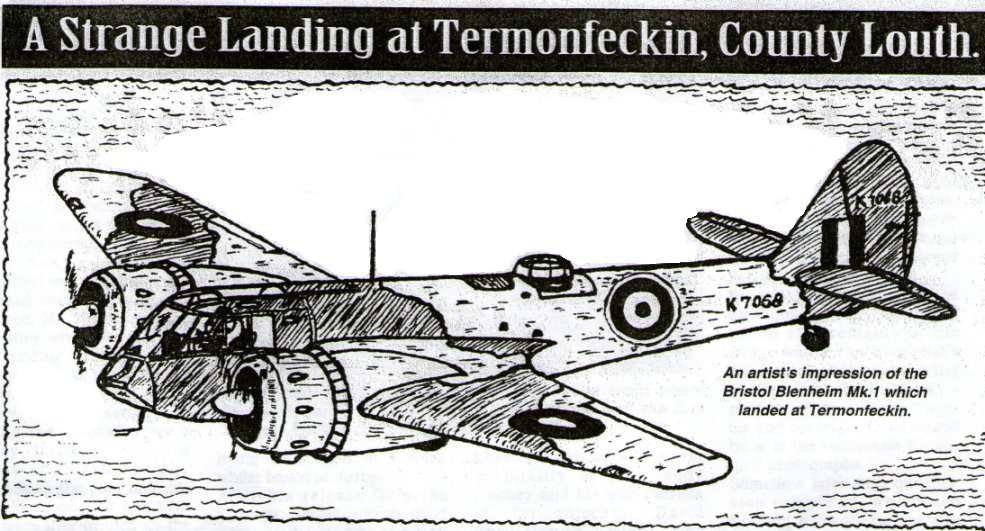
'Pilot returns 55 years later to scene of miracle escape'
by Michael O'Reilly
ON the evening of Thursday, 13th March, 1941 a twin engine Blenheim Mk l medium bomber took off from its base at RAF Jurby, Isle of Man. The aircraft belonged to the 5th. Bombing and Gunnery Squadron; this being a training unit for bombardiers and air gunners. The pilot was ferrying a fellow serviceman to Squire's Gate aerodrome near Blackpool, Lancashire.
After dropping off his passenger the pilot set course for the return trip to Jurby. However due to a combination of deteriorating visibility, compass inaccuracy and lack of a radio he could not locate his base. With the intention of landing at an alternative aerodrome or suitable field in Northern Ireland he then set out on a westerly course.
By 8.15 p.m. the aircraft was circling low over Irish territory and seeking a field to land in. However, unknowing to the pilot , he was over Termonfeckin, County Louth in neutral Eire. At this time of the evening the light was just declining as during these wartime years the clocks were left on summertime all year round. He made an attempt to land in Peter Flanagan's 'nine acres field' off the Seapoint road, Termonfeckin, but had to take off again as the field was too small. He then headed further inland and started circling over the townland of Belcotton just North West of the village.
Soon afterwards the aircraft was observed approaching with its undercarriage Iowered from a Northern direction. It was heading for a field at Nunneryland which was owned by Mr. Thomas Feehan. However as the plane had to clear some trees on the field boundary it did not acquire sufficient landing run and so careered with great force through the opposite hedge and ditch into the adjacent field. The aircraft finally came to a halt about 400 yards from the Feehan family's two-story thatched farmhouse! The front of the aircraft was fairly extensively damaged. It was leaning over onto its starboard wing and engine as the undercarriage wheel on that side had been ripped off. The glazed nose was buckled and distorted, some of the damage extending into the cockpit.
During the collision with the ditch the instrument panel was pushed down onto the stirrup type rudder pedals, injuring and pinioning the pilot's right foot. To free himself be had to wriggle his foot out of his trapped flying boot. Then reaching overhead he tried to slide back the access hatch, however it was jammed. Eventually he managed to get out of the cockpit by crawling through the broken nose glazing. Hobbling on his injured and bootless right foot for some distance from the aircraft he then lay down on the grass on his right elbow and lit a cigarette!
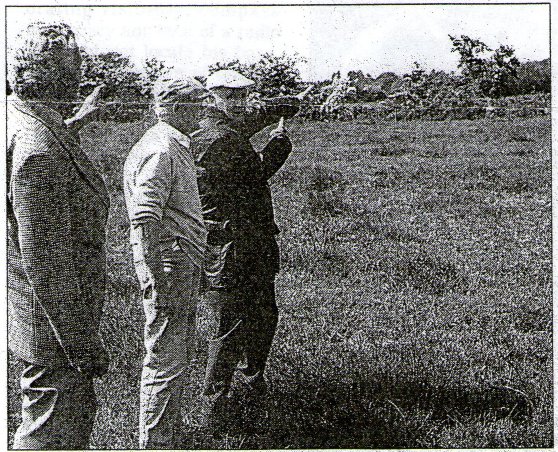 Photograph
taken at Nunnery/and, Termonfeckin on the 21st. June, 1996.
David Sutherland centre, stands at the spot where his Blenheim
came to a halt. Left is Paddy Mooney, right is Kevin Murphy.
Photograph
taken at Nunnery/and, Termonfeckin on the 21st. June, 1996.
David Sutherland centre, stands at the spot where his Blenheim
came to a halt. Left is Paddy Mooney, right is Kevin Murphy.
Mr. Thomas Feehan (in his mid forties) was working in his farmyard with a 19 year old employee, Mr. Kevin Murphy, when they witnessed the aircraft landing. Within 4 minutes they were at the scene, as also was 15 years old Paddy Mooney, the latter having been tracing the aircraft from a nearby laneway. Thomas Feehan and Kevin Murphy soon helped the pilot onto his feet and supporting him with their arms they headed for the farm house. They brought him in by the back door of the charming old residence and sat him down in a warm and cosy room which was lit by a paraffin lamp. Hospitality was extended to the airman in the form of warm refreshments until an army lorry arrived and brought him to Drogheda Garda Barracks. From there he was taken by ambulance to Gormanstown Military Camp and then to St. Bricin's Military Hospital, Dublin. Later still he was transferred to the Curragh Camp Hospital; this was the start of two and a half years of internment, until his release in October, 1943.
RETURN JOURNEY
The airman was 25 years old Sergeant Pilot David Sutherland, a native of Stirling. Scotland. He had only just married in 1940 and was living 'off station' at Ramsay whilst based at Jurby.
After his release from the Curragh, Sergeant Sutherland continued flying in the RAF until he left the service at the end of the war. However he rejoined a couple of years later and became an air traffic controller: one of his postings in this capacity was a two and a half years stint in India. David finally retired from the RAF in 1961, and is presently residing as a widower in South of England.
Just before Christmas 1995, David's and the author's paths crossed for the first time, by correspondence. His reason for writing was simple. After all of those years he still wanted to know where exactly he landed in County Louth and if possible to meet and thank the two men who brought him to the farmhouse for tea!
Research was soon set in motion as a result of valuable historical support from the army military archives and the hospitality of Mr. Paddy Mooney and his wife Patricia of Termonfeckin, David Sutherland's wish was realised.
It was a very pleasant sunny midsummer's afternoon on Friday, 21st June, 1996 when four men, including the author assembled in the 'landing field' at Nunneryland, Termonfeckln. David Sutherland had arrived from England a few days earlier. This was his first trip to the field since he landed there 55 years before. David was flanked by two local men: Kevin Murphy who had helped bring him to the farmhouse for tea, and Paddy Mooney, the schoolboy spectator at the time. Alas Thomas Feehan is now deceased.
We took many photographs including some of the wide gap which still remains in the hedge where the Blenheim's 54 foot 6 inch span wing scythed through. There was a mixture of good hearted banter and nostalgia as we retired back to the farmhouse for our final photographs.
Sometime later with our mission completed, we started heading
homewards. The sun still shone, the scent of new mown meadows
filled the air. David was contented and glad be made the journey
..... it was very special to him ...... for it was a sentimental
journey.
Written by Michael O'Reilly, 1995
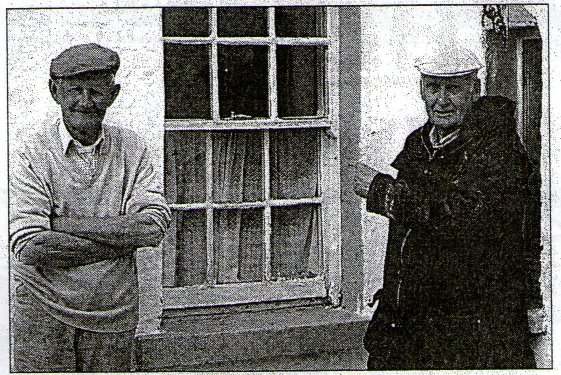 |
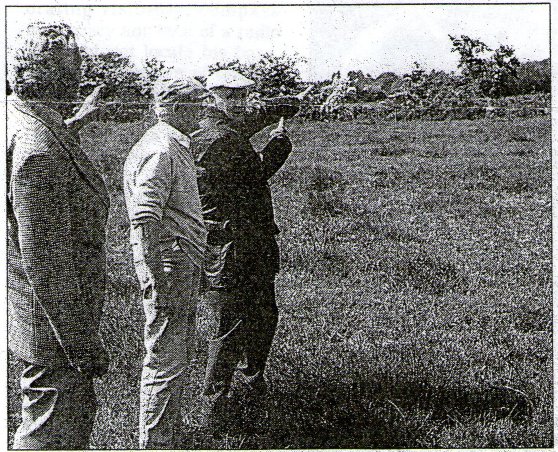 |
|
David Sutherland points to the window of the room where 55 years earlier Kevin Murphy (on the left) and the late Thomas Feehan brought the young pilot for tea. |
Paddy and Kevin point to the gap which still exists In the hedge where the Blenheim ploughed through. |
End of M O'Reillys article.
Th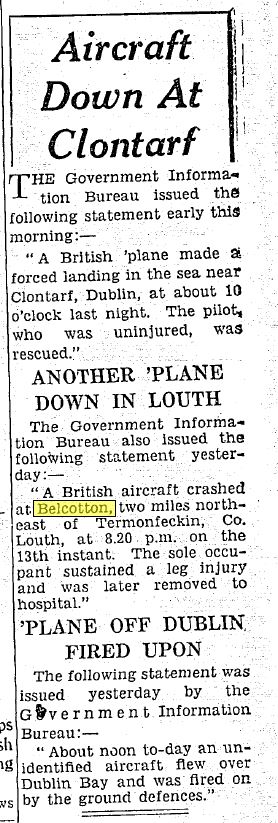 is incident took place
at a time when the Irish government was still reporting on the
landings or foreign aircraft in neutral Ireland and thus the
newspapers in Ireland carried reports on the incident. Thus the
Government Information Bureau statement was published in a
number of newspapers. The example shown is from the Irish
Independent, Saturday March 15th.
is incident took place
at a time when the Irish government was still reporting on the
landings or foreign aircraft in neutral Ireland and thus the
newspapers in Ireland carried reports on the incident. Thus the
Government Information Bureau statement was published in a
number of newspapers. The example shown is from the Irish
Independent, Saturday March 15th.
The second aircraft refers to the landing of another Blenheim
only the night after David Sutherland's arrival, at Clontarf in
Dublin.
Two photos taken of Sgt Sutherland's damaged Blenheim in the
field in Louth by an Irish Army Officer show the extent of the
damage. These images were kindly supplied by Mr. A
Flanaghan.
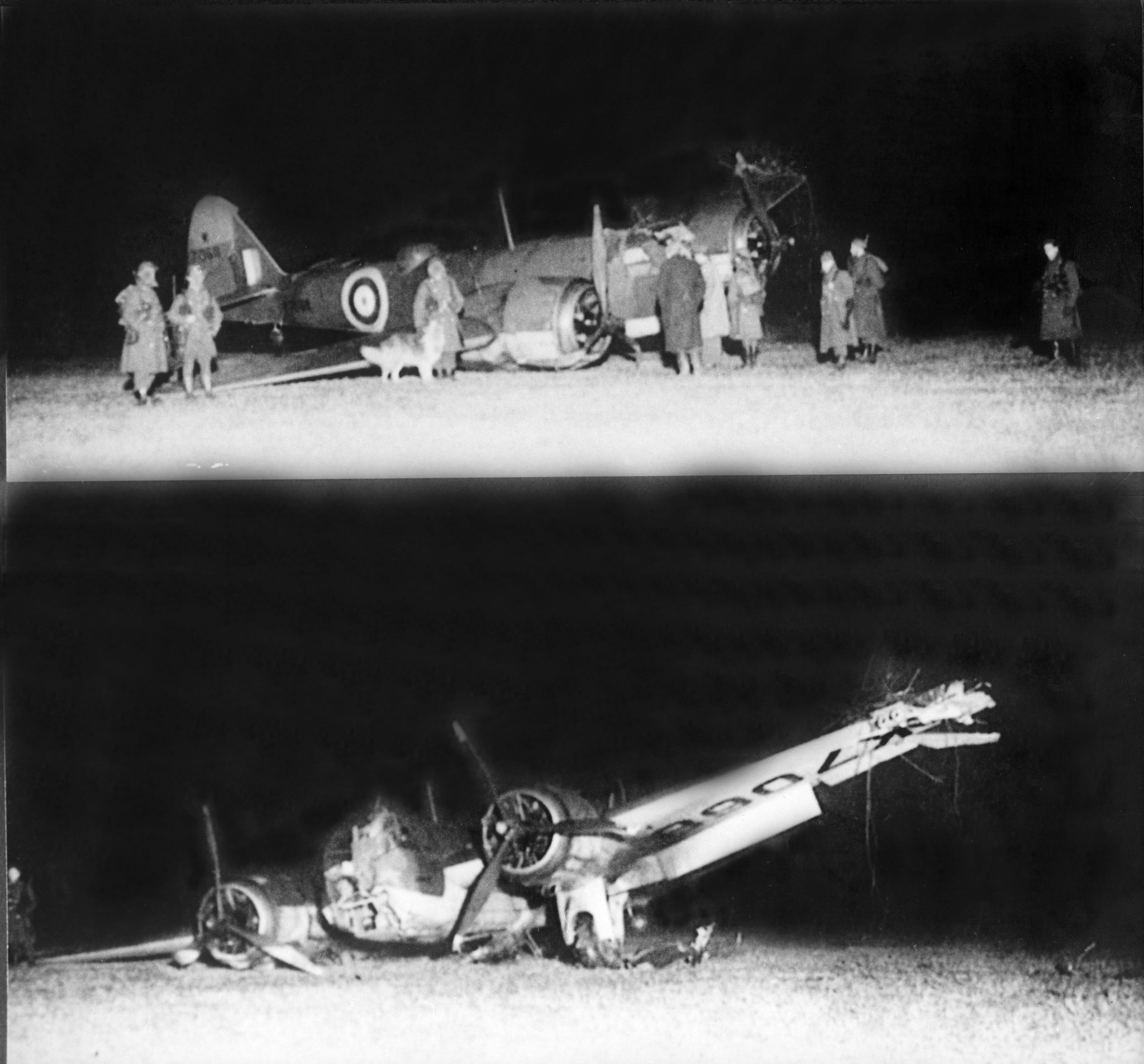
The Stirling Observer newspaper of the 20th and 22 May 1941,
carried this small article about David and his plight. He
and Irene had married in Birnie Parish Church on 4th May
1940. He was based at RAF Jurby at the time of his wedding
as this is the address of usual residence he gave. His
parents, Mary and William Sutherland were both deceased at that
point.
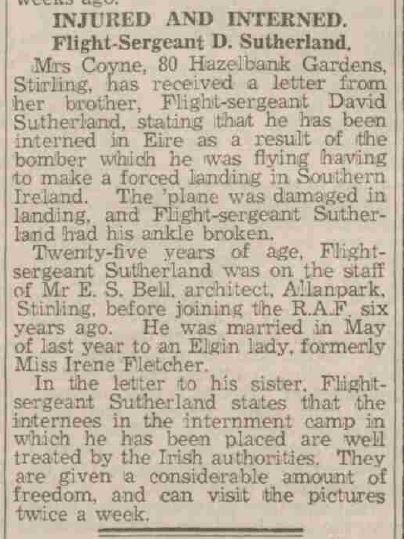
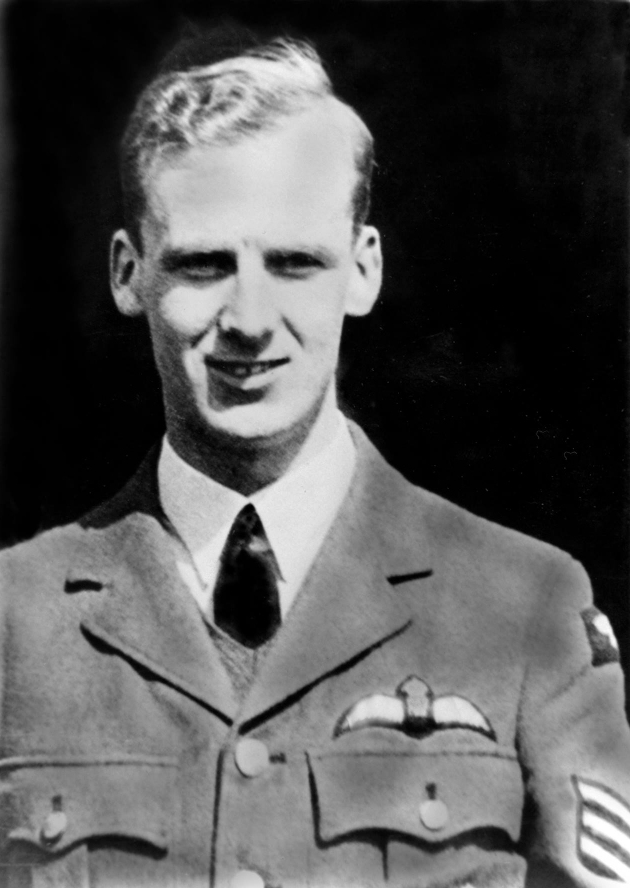 Sgt
Sutherland upon his return to the RAF in October 1943 was
interviewed and had an report filed under the title
'Repatriation from Eire' similar to the other airmen released in
1943. The report recorded his birth as being in 18 March, 1916,
and that he had been a pre-war regular member of the RAF since 3
April 1935. The photo of David was provided by Mr A
Flanaghan in 2019.
Sgt
Sutherland upon his return to the RAF in October 1943 was
interviewed and had an report filed under the title
'Repatriation from Eire' similar to the other airmen released in
1943. The report recorded his birth as being in 18 March, 1916,
and that he had been a pre-war regular member of the RAF since 3
April 1935. The photo of David was provided by Mr A
Flanaghan in 2019.
His narrative report states: I was detailed to convey
an airman on a rush posting from JURBY (Isle of Man) to
SQUIRES GATE (Lytham St Annes, Lancs.) on 13 Mar 41. ON
the return Journey I was forced to make a dusk landing near
Drogheda and was interned at CURRAGH Camp, after being taken
to DUBLIN Hospital with a broken ankle.
The RAF crash form for this incident recorded the following as
the reason for the aircraft loss:
F.L. (Lost bad visibility)
Passed E.T.A. - Decided to carry on to N. Ireland - unable to
pinpoint posn. in failing light + poor vis. Unable to fix
posn. with map which was 1 in 1/2 million R.A.F. map.
F.L. into ditch.
A.O.C. - Pilot failed to employ sufficient care in working out
his course + to use his common sense in an emergency.
In the above, F.L. refers to a 'Forced Landing' which A.O.C. refers to the Air Officer Commanding, in this case probably the head of 5 Bombing and Gunnery School (5 B&GS) based at at Jurby. The crash report also lists his training as having taken place at numbers 4 and 15 Elementary Flying Training Schools. He had suffered a take off accident in the summer of 1940, still while at 5 B&GS. It is is not known at this time what his role was with the school but it is thought he was a staff pilot or instructor.
He states that he was unsuccessful in his participation in at
least two of the escape bids, in February and August 1942.
He remained on the Isle of man after his release and raised his
family there.
The daughters of another British internee, Robert Harkell, were
able to provide the following group photo of some of the British
internees. The three men standing at the rear of the photo
in civilian attire were local civilians. Those faces that
can be identified are believed to be:
In the front row of the photo, from left to right
Sgt Robert George HARKELL 749495
Sgt Norman Vyner TODD 551678
Sgt William BARNETT 973926
Sgt David SUTHERLAND 51946
It seems most likely that the tall man standing at the very left
of the photo is Sgt Herbert Wain RICKETTS 581473.
The airman with the light coloured hair standing at the middle
is Sgt George Victor JEFFERSON 816145
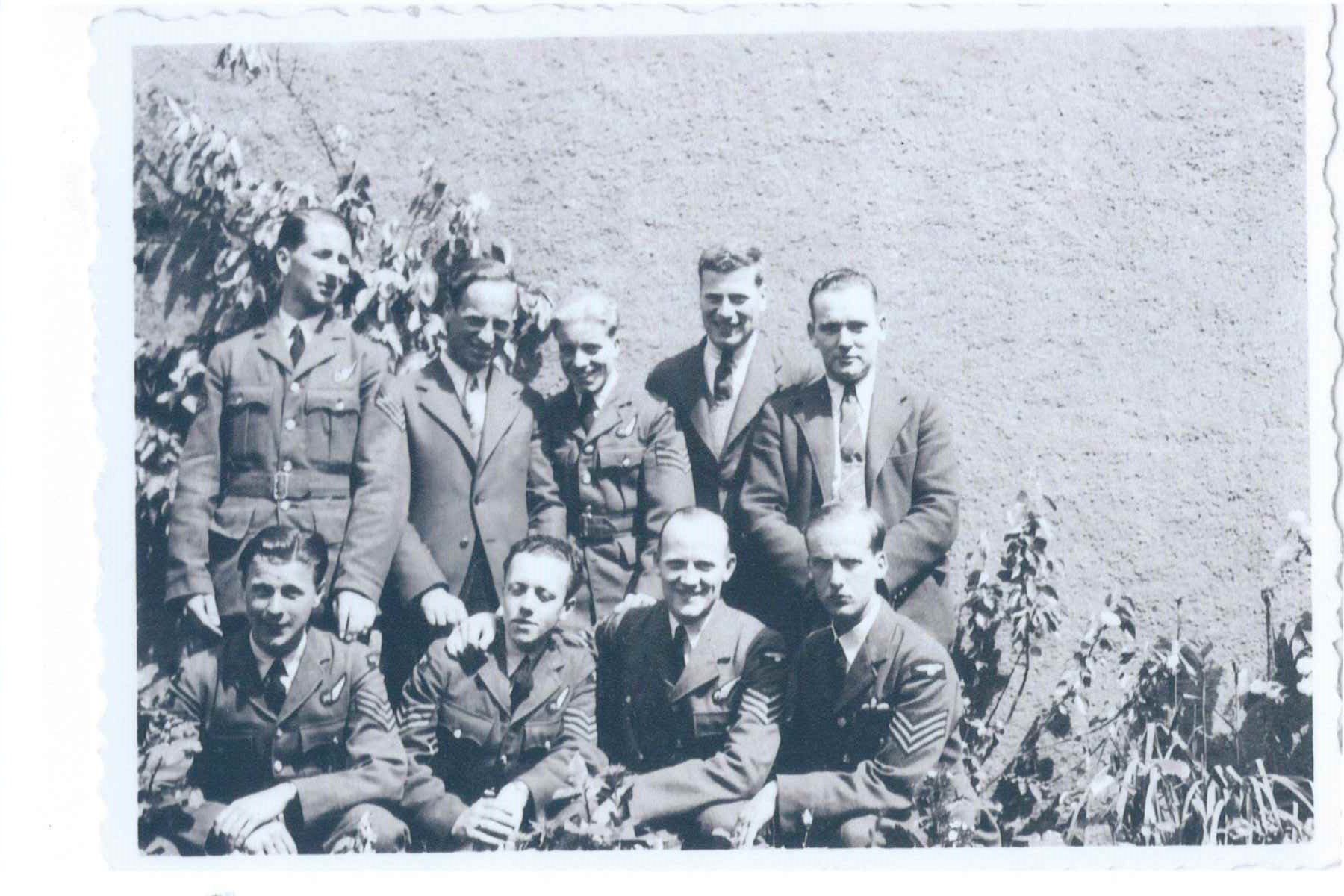
Another photo from the family of internee S J Hobbs included
David.
It is not known when the image below was taken exactly, but it
includes both Sgt Hobbs and F/Lt Proctor so is likely to have
been around the time of Sydney Hobbs wedding, though the lady in
the photo does not appear to be his wife Joan. This small
and battered photo shows the following Royal Air Force
internees:
Standing, Left to Right: Herbert Wain RICKETTS, Denys
Welply, David SUTHERLAND, Douglas Victor NEWPORT, Leslie John
WARD, Robert George HARKELL, William Allan PROCTOR, George
Victor JEFFERSON and Aubrey Richard COVINGTON.
Kneeling, Left to Right: Norman Vyner TODD, Sydney John
HOBBS.
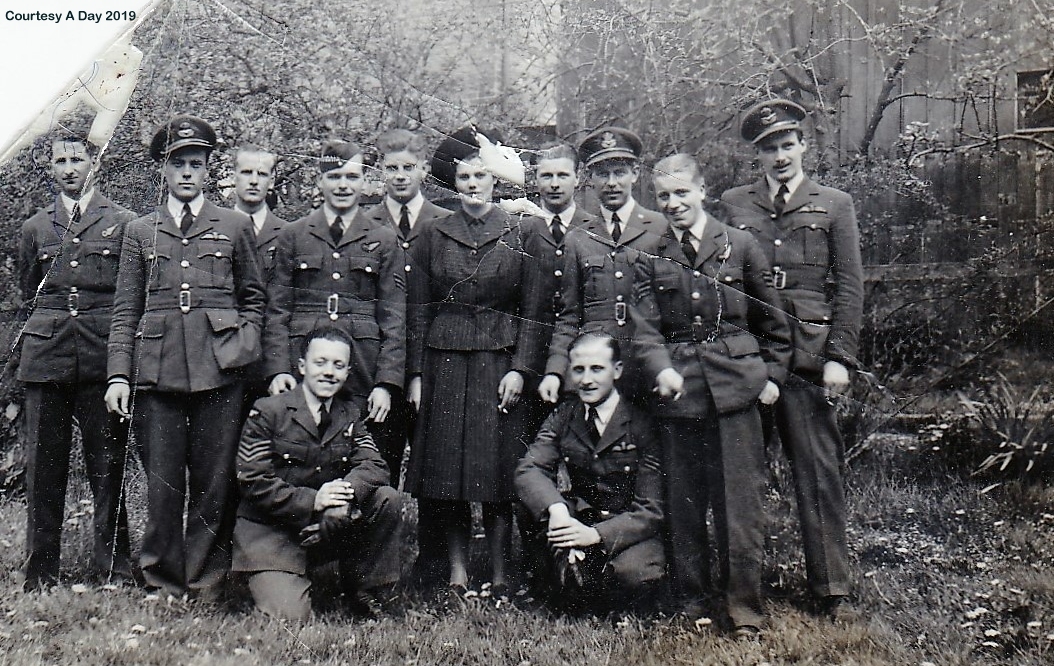
David's brother, Pvt James Sutherland served in the Argyl and
Sutherland Highlanders and fought in the Middle East and in
Normandy. A July 1944 report on Pvt Sutherland mentions
David as having been interned in Ireland but at that stage had
'rejoined his unit'. His wife's address remained listed as
in the Isle of Man throughout his internment in Ireland.
It is thought that they had their family there during the war.
David passed away in 2005 in Hampshire.
Additional information added to digital version by Dennis Burke, 2012 - 2019.
